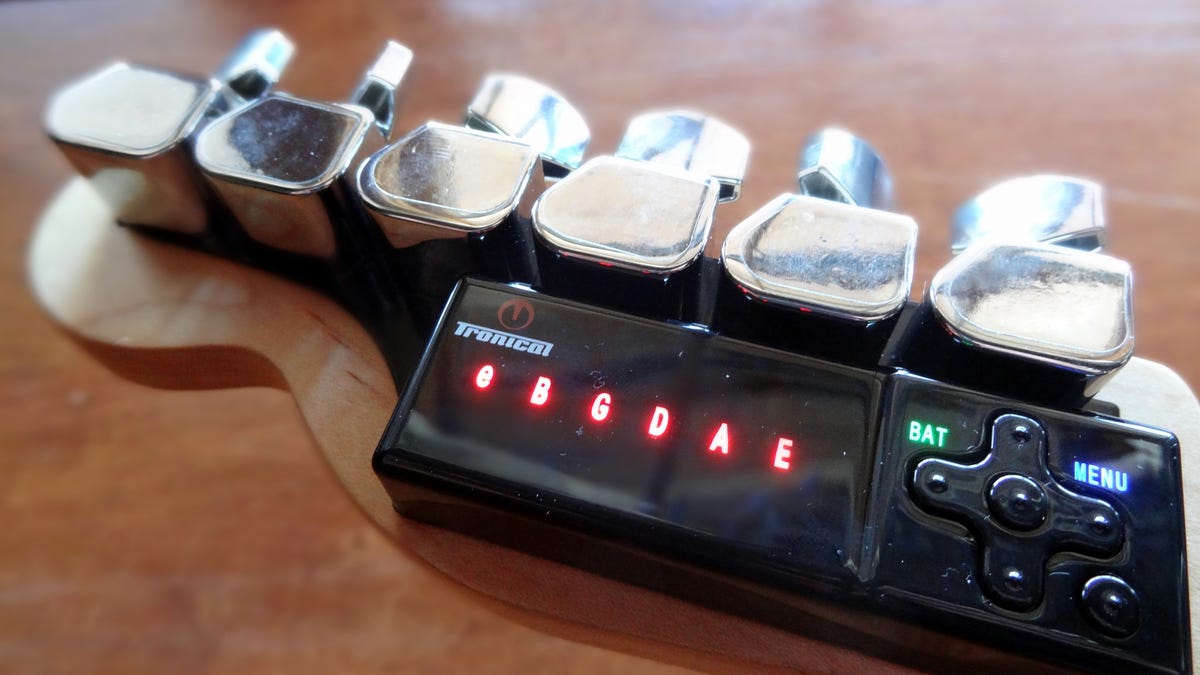TronicalTune: A robot tuner for almost any guitar (hands-on)
Crave writer Amanda Kooser puts the TronicalTune automatic guitar tuner through its paces, from installation to rocking out.

I took my custom champagne-sparkle Telecaster electric guitar to a party last weekend full of local musicians. I'm used to people ogling the paint job, but this time they were ogling the back of the headstock, and for a good reason. I had just installed the TronicalTune, an automated robotic tuning system.
There were a lot of "ahs" and "that's so cool!" comments as I pushed a couple of buttons and the tuners started spinning around on their own, like little magic silver dervishes. The tiny motors make a satisfying whirring noise, but the device also works surprisingly well. It puts your guitar into your choice of 18 different tunings, from standard to whatever your imagination can come up with.
Tune it or die
Some people are going to look at this system with a little contempt. "Why don't you just tune the guitar yourself? What's the matter, are you lazy?" they'll ask. "Don't you know how to tune?" Yes, I do know how to tune. What TronicalTune does is make the whole process faster, for quick changes during live performances. At $299, however, it's not going to be for everyone.
You'll get the most out of TronicalTune if you do know how to tune, and enjoy playing in alternate tunings. It already has 12 preset tunings, including popular ones like Drop D and Open G (I'm looking at you, Keith Richards). An additional six presets can be programmed with tunings of your own design. A microprocessor and algorithms power the process of getting the strings to the right pitch.
Installation
I didn't even consider going to a guitar shop to install the TronicalTune. The first step is ensuring it will fit your guitar. The company offers models for most common Gibson and Fender headstock styles, as well as ones that fit instruments from other manufacturers (not Martin yet, though). My custom Tele uses a standard Mexican Fender neck, so I was in business with the TronicalTune Type C model.
The first step is removing your old tuners. I de-tuned, took the strings off, and removed the stock tuners with a small wrench. The TronicalTune lined up perfectly with the holes. I put on the washers, tightened down the nuts, and charged up the small battery.
The TronicalTune system looks fairly normal from the front of the guitar, as all the weird bits with the buttons and LED lights are hidden behind the headstock. I was afraid it might upset the balance of the instrument considering that it weighs more than my old tuners, but the heft of the guitar's body made the change unnoticeable when I strapped it on. It may be a different story if you're installing this on an acoustic guitar.
Guitar players used to poking their strings through a little hole in the tuner will have to adjust to the different method employed by the TronicalTune. It involves wrapping the string around the peg, through a little notch, and around a little more. It's all tightened into place with a lock nut. Once you figure out the first string, the rest are easy.
Play time
I'll have to admit that when I use the TronicalTune, I feel pretty high-tech, like I should be backing Lady Gaga while wearing a mirror-ball jumpsuit. A couple of button pushes get you to your preferred tuning. Strum the strings and the tuners take over, whirring until all the strings are in tune. If it's not quite right, the tuner will ask you to mute the strings and play individual strings until everything is in tune, then it shuts itself off to conserve battery.
When I took the guitar to that house party full of musicians, I had a chance to plug it in and play in a noisy room full of approximately 20 other amps and instruments. The tuner didn't seem to mind the ambient racket, because it tuned up just as dutifully as it had at home. Every now and then, it doesn't quite get it right and I've had to run it a second time to really dial it in. There are quite a few configuration options, like accuracy, robohead delay, speed, and interference level, so I expect to fine-tune the system to match my guitar as I continue to play with it.
My most-used tunings are standard and Open D, so I've been switching between those two a lot as I test out the gadget. But I like the feeling of power of being able to switch to DADGAD or Open E on a whim. The only catch here is remembering which memory bank and location the tuning is in. You'll want to keep a cheat sheet handy until you have it sorted out in your head.
Is it worth it?
That depends. Several hundred dollars is a lot for a tuner, but it's really more about the convenience of the thing. I went into this whole experiment feeling skeptical about the system and old-school about the way I handle my guitars. I've come out the other side impressed with the ease of installation and the fact that it does a solid job of tuning.
I've always disliked having to pause in the middle of a show to change tunings, and I'm also not a fan of hauling more than one guitar along to a gig. The TronicalTune takes care of all of that. Plus, the most interesting thing about my Tele is no longer the eye-yanking paint job. It's the little robot behind the headstock.

